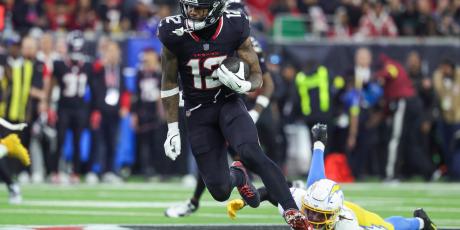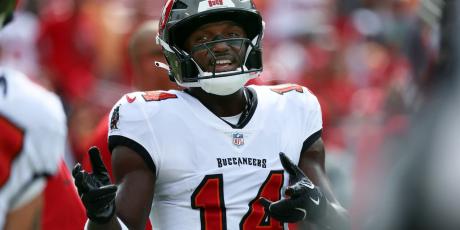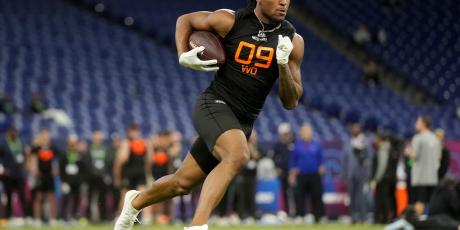How to Pinpoint Fantasy Football Sleepers

Sleepers. We all love them, but how do you find them?
It requires a disciplined approach, with an ability to use information and statistics, while ignoring training camp rhetoric and Twitter practice videos, to form opinions on players.
Our goal is to pinpoint players our league mates pass over because they bypassed critical information that illustrates an opportunity to produce.
Finding sleepers is about evaluating risk. How much risk you can stomach should be a direct correlation to draft round. The deeper you go into a fantasy draft, the more tolerance you should have for a player with a low floor.
Below are some of the best practices for pinpointing sleepers.
Ranking Versus Average Draft Position
You simply cannot find sleepers without studying the nexus of trusted rankings and average draft position (ADP) data. Without a cross-comparison of the two, you are exercising the fantasy football equivalent of throwing darts.
4for4’s rankings are a great place to start. Overall, they have been some of the most accurate rankings in the industry since 2010, with 4for4 Senior Editor John Paulsen twice earning top honors for most accurate rankings, along with a handful of top-5 accuracy awards.
Take your rankings and make sure to include the latest ADP on each player. 4for4’s rankings already do this for you with a column on the far right side of each rankings page indicating their ADP in both 10- and 12-team leagues.
Often, you’ll find the highest ranked players at each position fall pretty close in line with their ADP, but the deeper you get into drafts, the more you will see names creep up your rankings ahead of their ADP.
For example, in PPR leagues, 49ers receiver Pierre Garcon has an ADP in the eighth round; however, he is WR24 in 4for4’s PPR rankings, ahead of a handful of wideouts with ADPs in rounds three through six. This could allow you to reach on Garcon a round early to ensure you get him but also pass on similarly ranked running backs in earlier rounds to take another position instead, thereby making your overall roster stronger.
Finding sleepers effectively is not possible without trusted rankings and ADP.
Site Specific Ranking Versus Average Draft Position
You can even go a step further and cross-reference ADP from the site that hosts your fantasy league with 4for4 rankings. Even better, we’ve already done that for you in our sleeper series for Yahoo, ESPN, CBS, and NFL.com!
Jump To Table: 4for4 Standard Rankings vs. CBS ADP | 4for4 PPR Rankings vs. CBS ADP
Jump To Table: 4for4 Standard Rankings vs. NFL.com ADP | 4for4 PPR Rankings vs. NFL.com ADP
Jump To Table: 4for4 Standard Rankings vs. ESPN ADP | 4for4 PPR Rankings vs. ESPN ADP
Jump To Table: 4for4 Standard Rankings vs. Yahoo ADP | 4for4 PPR Rankings vs. Yahoo ADP
These articles and tables will be updated multiple times in August through Labor Day weekend.
Bounce Back Candidates: Why'd They Have a Poor Season?
Often, sleepers are players who had poor seasons the year before, which results in other teams in your league passing because they no longer trust them. However, it is important to know why that player had a poor season; looking at their stat line isn’t enough.
In 2014, Cardinals wide receiver Larry Fitzgerald had the worst fantasy season of his career (63-784-2), but it wasn’t his fault. Fitzgerald's poor season saw him drafted on average as the WR29 in 2015 drafts. In most 12-team leagues, he was still on the board in the eighth round. Entering his age-32 season, most thought Fitzgerald was washed up. They completely ignored the fact his quarterbacks for 10 games in 2014 were Drew Stanton, Ryan Lindley, and Logan Thomas. Those who looked beyond the box score, as 4for4 did, were richly rewarded by Fitzgerald’s 2015 season, where he finished as the WR7 in PPR leagues.
Sometimes drafters ignore a player coming off a good season altogether. Michael Crabtree was the 38th WR off the board in MFL10 drafts last year, after an 85-922-9 line in his first season as a Raider. Crabtree finished as the WR12 in 2016.
Another pitfall in pinpointing sleepers is ignoring talent and opportunity, instead emphasizing a season cut short by injury. Tyrod Taylor literally only missed one game last year (Week 17). He was eighth in fantasy points per game and now finds himself with a 2017 ADP of QB16. Danny Woodhead was another great example of this going into 2015, after only playing three games in 2014. He finished, incredibly, as the RB3 in PPR leagues. Drafters ignored him, despite the fact he already had an RB15 finish in 2013. Perhaps he does it again in 2017? Maybe Theo Riddick follows a similar path after missing six games last year, which has depressed his current ADP into the eighth round.
Passing on Sleepers
Is it okay to pass on players labeled as sleepers when they are coming off multiple healthy seasons that didn’t meet expectations? In those cases, touting sleepers is blindly lobbying a return to glory days, while ignoring real data.
Two words: Trent. Richardson. Some touted him as a sleeper in 2014, when he was being drafted on average in rounds six and seven. The reasoning? Many thought he had a full grasp of the Colts offense heading into his second season with the team following a midseason trade the year before. Maybe that was true, but that’s not real data, is it?
Real data was Richardson averaging only 3.9 yards per carry as a rookie, regressing to 3.4 yards per carry in year two as a Brown, and then dropping all the way down to 2.9 yards per carry following his trade to the Colts. The result? A yards-per-carry average of 3.3 in his first (and final) full season with the Colts. If the argument for a sleeper is more subjective than objective, it’s probably best to pass.
LeGarrette Blount scares me in 2017. His eighth-round ADP has led to him being touted as a sleeper once again by some, and they are backing up that stance by referencing his 18 touchdowns last year as the reason for it, despite him going from the Patriots to the Eagles, a far lower scoring team. Blount’s 299 carries last year (over 60% RB touch share in New England) were second in the NFL behind Ezekiel Elliott. That volume will not be there in Philadelphia, where early-down back Ryan Mathews saw less than 50 percent of the backfield touches.
Plus, Blount’s efficiency has been below average for three straight years, all under 4.5 yards per carry. Behind an above-average Patriots offensive line in 2016, that average dipped to an alarming 3.9 yards per carry.
Who is the Offensive Coordinator/Playcaller?
Sometimes with sleepers, we have less objective data to go by with the player himself but more objective data to go by with past results of his offensive coordinator.
Before the 2016 season, 4for4's Associate Editor TJ Hernandez studied what Hue Jackson’s move to the Browns would mean for fantasy. He noted: “Over the last 10 seasons, only three active play callers have averaged a higher percentage of run plays called than Jackson, and no coach has been more consistent in their pass/run splits over that span.” That type of valuable information could have allowed you to scoop up Isaiah Crowell in the 11th round ahead of his RB14 finish in PPR leagues last year.
Ahead of the 2015 season, Hernandez studied what new Jets offensive coordinator Chan Gailey would mean to his weapons. What he found for running backs was interesting: even in Gailey’s last three years as the playcaller, when his top running back only received 56.3 percent of backfield touches, Gailey’s main back still averaged 14.9 PPR fantasy points per game over his last four seasons, with two of those seasons resulting in RB1 finishes in terms of points per game.
Savvy drafters knew this meant it would lead to a great opportunity for Chris Ivory, who was being drafted on average in the eighth round of 12-team leagues in 2015. Ivory finished as the RB9 in standard leagues and RB12 in PPR leagues, averaging 13.5 PPR points per game.
Patience During the Season
Pinpointing sleepers is also about being patient. If you studied enough to draft a player, why would you drop him before the start of the season or a couple weeks into it?
How many people drafted Odell Beckham Jr. as a rookie only to drop him before he played a down in the NFL after an injury forced him to miss the first four games of the season? How many of those fantasy players then watched another team win a championship with Beckham?
Did you drop Jay Ajayi last year after he was made inactive in Week 1, despite all the signs Arian Foster would not stay healthy in 2017 and Miami had no other viable early-down backs?
Is this hindsight analysis? Yes, but those who don’t learn from history are doomed to repeat it.
Quarterbacks: Past Success in the System
One poor season does not make a career. Ask people who passed on Cam Newton and his QB10 ADP in 2015, only to watch him finish as the season's overall highest scoring fantasy signal-caller.
Who might be the next bounce back candidate at the position? How about Andy Dalton, who was 12th and fifth among fantasy quarterbacks in 2012 and 2013, respectively. Or Eli Manning, who was QB10 in 2014 and 2015. Philip Rivers was a top-12 quarterback from 2013 to 2015 before dipping slightly to QB14 last season. All of these quarterbacks have depressed ADPs.
You can click here for a more in-depth look at year-to-year fantasy consistency for quarterbacks.
Running Backs: No Established Incumbent Starter
In the middle-to-late rounds of drafts, far too often do we see the "brand name" running back in a committee get drafted over a less sexy name who actually has a larger role in his offense.
The 2010 Houston Texas is a perfect example. Arian Foster’s ADP finished in the sixth round of 12-team leagues that year, but I promise you it was skewed by late drafters. It was even lower for weeks, despite reports he won the starting job in training camp and the preseason over Steve Slaton and Derrick Ward. Foster rushed for more than 1,600 yards that season. Could we have predicted that type of production? Of course not, but we do know you don’t even have a chance if you aren’t the starter.
You’ll find some of the other names drafted ahead of Foster in 2010 interesting:
- C.J. Spiller—a backup rookie who rushed for 283 yards and 0 touchdowns.
- Ronnie Brown—who split touches with Ricky Williams.
- Jonathan Stewart—who was in a three-person committee at the time with Mike Goodson and DeAngelo Williams.
- Beanie Wells—was drafted almost two rounds earlier than Foster and was on the wrong side of a timeshare with Tim Hightower.
There are more examples, but you get the point. In the middle-to-late rounds, pinpoint running back sleepers based on how much of the backfield pie they should get in the upcoming season. In 2017, Tampa Bay’s backfield comes to mind with Doug Martin suspended or perhaps Dalvin Cook in Minnesota.
Running Backs: Can He Catch?
In PPR leagues, an obvious but sometimes overlooked way to pinpoint running back sleepers is simply asking if that back is utilized in the passing attack.
4for4’s 2017 PPR draft rankings illustrate this perfectly for running backs. Marshawn Lynch is reportedly going to see around just 200 carries this season but is still being drafted in the third round, multiple rounds ahead of very capable pass-catching running backs like Theo Riddick and Bilal Powell. That’s solid sleeper material. Amateur fantasy players underestimate how much receptions impact running back scoring leaders in PPR leagues.
Even deeper into 2017 drafts, a player like James White is available in the 10th round or later. He was third in RB receptions behind David Johnson and Le’Veon Bell and continues to operate in an offense always among the league leaders in plays per game.
Wide Receivers: Fantasy Points Per Touch
4for4 Senior Editor John Paulsen annually pinpoints breakout receivers using advanced statistics. He is fond of fantasy points per target and with good reason. If a receiver is productive in limited snaps, it’s logical to assume he’ll be productive with more snaps.
That has been backed up by results in previous years. Paulsen wrote:
“...I featured Alshon Jeffery in the 2013 edition of this article. He posted a solid 1.14 FP/T (#37 in the league) on 48 targets during his injury-plagued rookie season. In his sophomore campaign he posted 1.24 FP/T on 149 targets, resulting in a #9 finish at his position.”
“In 2014, Golden Tate was the best example of a productive receiver who turned an increase in targets into a stellar fantasy season. As he joined the Lions, his targets jumped from 99 to 143, while his FP/T stayed relatively steady (1.21 in 2013, 1.10 in 2014). The result was a #13 finish at his position in standard formats.”
This is another way to pinpoint sleepers, even as deep as the last few rounds of your draft.
Wide Receivers: Beware of Rookie Receivers
The amazing receiver class of 2014 (Sammy Watkins, Mike Evans, Odell Beckham Jr., Kelvin Benjamin, etc.) had many scrambling to find the next big thing in 2015 drafts, only to fail to keep the proper context around a strong historical trend. Rarely do rookie receivers produce consistently enough for fantasy purposes.
Amari Cooper’s fourth-round price tag wasn’t worth it in 2015, as has been the case with most highly touted receivers outside the 2014 class. In 2016, drafters learned their lesson, with Corey Coleman being the highest drafted rookie WR at WR45 in MFL10 leagues in the 10th round, but even then, there was no return on investment.
| Year | Position Rank (PPR) | FP/G (PPR) |
|---|---|---|
| 2016 | WR7 | 17 |
| 2015 | WR21 | 13.3 |
| 2014 | WR7 | 24.6 |
| 2013 | WR19 | 14.6 |
| 2012 | WR27 | 12.7 |
| 2011 | WR17 | 14.7 |
In 2016, Michael Thomas emerged as a viable weapon with the Saints, but he was not a first round pick in the NFL Draft. However, the next best fantasy finish by a rookie receiver was Tyreek Hill at WR24, who was drafted by the Chiefs in the fifth round. Again, if you think drafting rookie receivers who were drafted highly in the NFL Draft is a sound strategy, think again. Sterling Shepard (WR36) was also a second round pick on Day Two of the draft in a year when four other receivers were selected on the first night.
In 2015, Amari Cooper was the only rookie receiver close to reliable fantasy production. Seahawks wideout Tyler Lockett was the next closest rookie, finishing as the WR44 in PPR leagues.
In 2013, Chargers receiver Keenan Allen, who was picked in the third round, finished as the WR19 in PPR leagues. None of his fellow rookie wideouts finished inside the top 40 in PPR leagues among receivers. That class included first round picks Tavon Austin, DeAndre Hopkins, and Cordarrelle Patterson.
In 2012, Colts wide receiver T.Y. Hilton, another receiver with a third-round pedigree (not exactly on many fantasy draft radars), was the top scoring fantasy rookie receiver, with first-round pick Justin Blackmon right behind him at WR28 in PPR leagues.
Even the 2011 rookie receiver class didn’t come close to the success of the 2014 class. A.J. Green and Julio Jones finished at WR17 and WR21, respectively, in 2011, but that still wasn’t close to the four rookie receivers who finished among the top-23 scoring receivers in 2014 PPR leagues. That grouping excludes Brandin Cooks, who averaged 13.9 PPR points per game as a rookie, right up there with the top rookie wideouts from years outside of 2014.
2014’s rookie class of receivers was a huge outlier. Many chased those same results in 2015, resulting in fantasy doom. 2016’s receivers selected in the first round of the NFL Draft also bombed in being consistent fantasy assets: Corey Coleman, Will Fuller, Josh Doctson, and Laquon Treadwell.
In future years, it’s important to know the history of rookie receivers when searching for sleepers. History shows us second-year receivers are more likely to breakout and make better sleepers, as John Paulsen’s fantasy points per target study above told us.
Still Awake? A Recap on Pinpointing Sleepers
There is a laundry list of ways to pinpoint sleepers in fantasy football drafts. To sum it all up, here are the best practices:
- Find rankings you trust and cross reference ADP.
- Use objective information and data, not subjective.
- If coming off a bad season, evaluate if it was the player’s fault.
- Past success > recent failure?
- RBs: Target backs with high workload potential or roles in the passing game.
- WRs: Fantasy points per target, beware of rookies.
Related Articles
- 10 Undervalued Fantasy Football Sleepers on Yahoo
- 12 Undervalued Fantasy Football Sleepers on ESPN
- 13 Undervalued Fantasy Football Sleepers on NFL.com
- 11 Undervalued Fantasy Football Sleepers on CBS
- Pinpointing Fantasy Football Sleepers (& Avoiding Traps)
- 10 Young Receivers Primed for a Breakout
- How Often do Top-12 PPR Tight Ends and Quarterbacks Repeat in the Following Season?






















